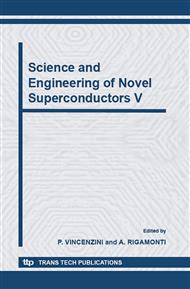p.113
p.118
p.124
p.131
p.137
p.143
p.153
p.159
p.165
Fabrication and Evaluation of Ag-Bi2223 Composite Tapes with Interfilamentary Resistive Barriers
Abstract:
We fabricated Ag-sheathed Bi2223 composite tapes with interfilamentary resistive barriers by using powder-in-tube (PIT) method and evaluated their AC loss characteristics at 77 K. The mixture of Ca2CuO3 and 30 wt% Bi2212 are used as the barrier material for tape fabrication. The barrier layers were coated on all surfaces of the hexagonal monocore wires. Then, several pieces of the coated wires were stacked and inserted into an Ag tube, and the composites were deformed into tape shape. By introducing the barrier layers between the filaments, the Jc values at 77 K and self-field are degraded about 15%. The loss measurements under AC parallel transverse magnetic field were systematically performed, as a function of field amplitude and frequency. The loss properties in the barrier tape were compared with those in the tape without barriers. The results indicated that introducing Ca2CuO3 barriers is effective to suppress the electromagnetic coupling among the filaments and also to reduce the magnetization losses under parallel transverse field. We also present the fabrication of the barrier tapes on the order of several meters, together with the uniformity of superconducting properties along a length direction.
Info:
Periodical:
Pages:
137-142
Citation:
Online since:
October 2006
Authors:
Keywords:
Price:
Сopyright:
© 2006 Trans Tech Publications Ltd. All Rights Reserved
Share:
Citation:


